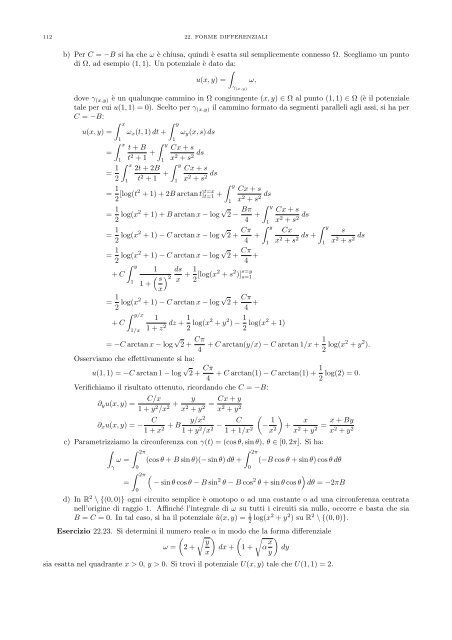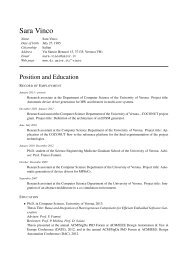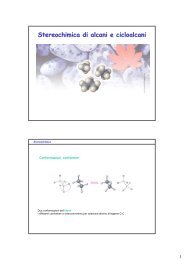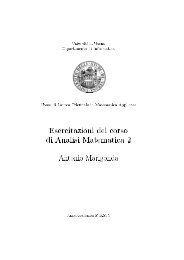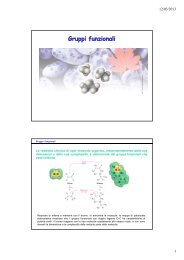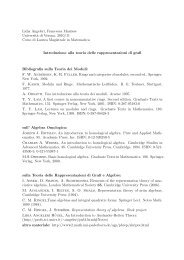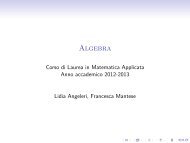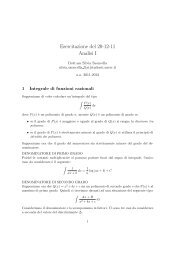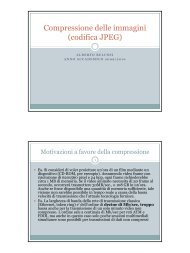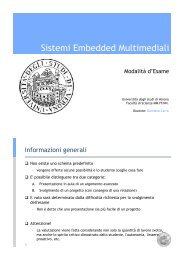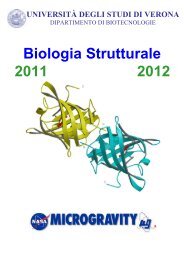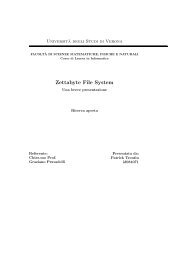You also want an ePaper? Increase the reach of your titles
YUMPU automatically turns print PDFs into web optimized ePapers that Google loves.
112 22. FORME DIFFERENZIALI<br />
b) Per C = −B si ha che ω è chiusa, quindi è esatta sul semplicemente connesso Ω. Scegliamo un punto<br />
di Ω, ad esempio (1, 1). Un potenziale è dato da:<br />
<br />
u(x, y) = ω,<br />
γ (x,y)<br />
dove γ (x,y) è un qualunque cammino in Ω congiungente (x, y) ∈ Ω al punto (1, 1) ∈ Ω (è il potenziale<br />
tale per cui u(1, 1) = 0). Scelto per γ (x,y) il cammino formato da segmenti paralleli agli assi, si ha per<br />
C = −B:<br />
u(x, y) =<br />
=<br />
x<br />
1<br />
x<br />
= 1<br />
2<br />
1<br />
x<br />
ωx(t, 1) dt +<br />
t + B<br />
t2 + 1 +<br />
1<br />
y<br />
1<br />
2t + 2B<br />
t 2 + 1 +<br />
y<br />
1<br />
ωy(x, s) ds<br />
Cx + s<br />
x2 ds<br />
+ s2 y<br />
1<br />
Cx + s<br />
x2 ds<br />
+ s2 = 1<br />
2 [log(t2 + 1) + 2B arctan t] t=x<br />
t=1 +<br />
y<br />
1<br />
Cx + s<br />
x2 ds<br />
+ s2 = 1<br />
2 log(x2 + 1) + B arctan x − log √ 2 − Bπ<br />
4 +<br />
= 1<br />
2 log(x2 + 1) − C arctan x − log √ 2 + Cπ<br />
4 +<br />
= 1<br />
2 log(x2 + 1) − C arctan x − log √ 2 + Cπ<br />
4 +<br />
+ C<br />
y<br />
1<br />
1<br />
<br />
s<br />
1 +<br />
x<br />
2<br />
ds<br />
x<br />
1<br />
+<br />
2 [log(x2 + s 2 )] s=y<br />
s=1<br />
= 1<br />
2 log(x2 + 1) − C arctan x − log √ 2 + Cπ<br />
4 +<br />
+ C<br />
y/x<br />
1/x<br />
y<br />
1<br />
y<br />
1 1<br />
dz +<br />
1 + z2 2 log(x2 + y 2 ) − 1<br />
2 log(x2 + 1)<br />
1<br />
Cx + s<br />
x2 ds<br />
+ s2 Cx<br />
x2 ds +<br />
+ s2 y<br />
1<br />
s<br />
x2 ds<br />
+ s2 = −C arctan x − log √ 2 + Cπ<br />
1<br />
+ C arctan(y/x) − C arctan 1/x +<br />
4 2 log(x2 + y 2 ).<br />
Osserviamo che effettivamente si ha:<br />
u(1, 1) = −C arctan 1 − log √ 2 + Cπ<br />
1<br />
+ C arctan(1) − C arctan(1) + log(2) = 0.<br />
4 2<br />
Verifichiamo il risultato ottenuto, ricordando che C = −B:<br />
∂yu(x, y) =<br />
C/x<br />
1 + y2 y<br />
+<br />
/x2 x2 Cx + y<br />
=<br />
+ y2 x2 + y2 ∂xu(x, y) = − C y/x2<br />
+ B<br />
1 + x2 1 + y2 C<br />
−<br />
/x2 1 + 1/x2 <br />
− 1<br />
x2 <br />
+<br />
x<br />
x2 x + By<br />
=<br />
+ y2 x2 + y2 c) Parametrizziamo la circonferenza con γ(t) = (cos θ, sin θ), θ ∈ [0, 2π]. Si ha:<br />
2π<br />
2π<br />
ω = (cos θ + B sin θ)(− sin θ) dθ + (−B cos θ + sin θ) cos θ dθ<br />
γ<br />
=<br />
0<br />
2π<br />
0<br />
<br />
− sin θ cos θ − B sin 2 θ − B cos 2 <br />
θ + sin θ cos θ dθ = −2πB<br />
d) In R 2 \ {(0, 0)} ogni circu<strong>it</strong>o semplice è omotopo o ad una costante o ad una circonferenza centrata<br />
nell’origine di raggio 1. Affinché l’integrale di ω su tutti i circu<strong>it</strong>i sia nullo, occorre e basta che sia<br />
B = C = 0. In tal caso, si ha il potenziale ũ(x, y) = 1<br />
2 log(x2 + y 2 ) su R 2 \ {(0, 0)}.<br />
Esercizio 22.23. Si determini il numero reale α in modo che la forma differenziale<br />
<br />
y<br />
ω = 2 + dx + 1 + α<br />
x<br />
x<br />
<br />
dy<br />
y<br />
sia esatta nel quadrante x > 0, y > 0. Si trovi il potenziale U(x, y) tale che U(1, 1) = 2.<br />
0


